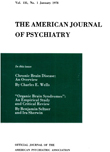CEREBRAL BLOOD FLOW AND METABOLISM IN SCHIZOPHRENIA
Abstract
Studies by the use of the nitrous oxide technique on 22 schizophrenic patients show no deviation from values obtained in normal young males for cerebral blood flow and oxygen consumption.
A clinically significant change in 8 patients given sodium pentothal or amytal intravenously is not associated with a measurable change in cerebral blood flow or cerebral oxygen consumption.
Insulin hypoglycemia and coma is associated with a progressive decrease in cerebral utilization of oxygen and blood glucose, the cerebral circulation remaining unimpaired. The fall in blood glucose utilization is greater than that of oxygen.
Electroshock is followed by a moderate decrease in metabolism and a marked decrease in cerebral blood flow in the face of a severe acidosis.
Although there were no demonstrable deviations from the normal in this group of schizophrenic patients, our experience with this technique leads us to believe that it is worthy of extensive application in the study of the metabolic derangements in the brain associated with mental disease. It makes possible a new approach to psychiatric disorders, and gives the means of quantitatively determining the utilization or production of any substance capable of accurate analysis in the arterial and internal jugular venous blood.
Access content
To read the fulltext, please use one of the options below to sign in or purchase access.- Personal login
- Institutional Login
- Sign in via OpenAthens
- Register for access
-
Please login/register if you wish to pair your device and check access availability.
Not a subscriber?
PsychiatryOnline subscription options offer access to the DSM-5 library, books, journals, CME, and patient resources. This all-in-one virtual library provides psychiatrists and mental health professionals with key resources for diagnosis, treatment, research, and professional development.
Need more help? PsychiatryOnline Customer Service may be reached by emailing [email protected] or by calling 800-368-5777 (in the U.S.) or 703-907-7322 (outside the U.S.).



